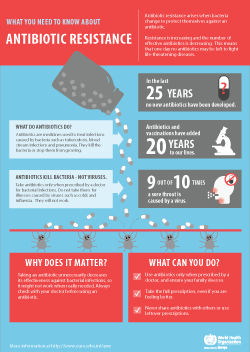Antibiotic resistance: a growing threat

Antibiotics are used to prevent and treat a vast range of diseases and conditions caused by bacteria, including tuberculosis, blood and wound infections, pneumonia and gonorrhoea. They do not work against viruses.
Discovered over 70 years ago, antibiotics have revolutionized health care, saving the lives of millions of people world wide and preventing life-threatening infections during surgery.
Now, people often take them for granted, and have lost sight of their importantance.
18 November is European Antibiotic Awareness Day (EAAD).
Antibiotic misuse
Because people are so used to taking antibiotics, they sometimes do so without considering whether they will be effective, and often do not take them correctly – not finishing the course of treatment, for example.
The misuse or overuse of antibiotics enables bacteria to adapt to protect themselves, so the antibiotics no longer work. This is called antibiotic resistance. It is a growing threat, as more and more bacteria are becoming resistant.
At the same time, no new classes of antibiotics have been discovered in the past 25 years. Thus, as existing antibiotics become ineffective, there are no new ones in the pipeline to replace them.
This means that one day no antibiotics may be left to treat common bacterial infections. This would make infections life threatening again, and take societies back to the conditions before antibiotics were discovered.
Alarming situation in Europe
Although awareness of antibiotic resistance is increasing, antibiotics can be bought over the counter, without a prescription, in two out of three countries in the eastern part of the WHO European Region. Better understanding is most needed in these countries.
Even in countries where antibiotic use is regulated and restricted, antibiotic resistance in health care settings – such as hospitals – is worrying. In the European Union, Norway and Iceland, 5–12% of hospital patients acquire an infection during their stay. Each year, about 400 000 people are infected with a resistant strain, and 25 000 of them die.
Yet this is not just a local or even regional problem. Deadly bacteria are crossing borders everywhere. In the last two years, virulent strains of Escherichia coli bacteria, resistant to almost all available antibiotics, have been found in Europe, imported from countries where they are widespread.
Effective surveillance needed
Last year, all 53 countries in the Region adopted an action plan to fight antibiotic resistance that:
- commits them to promote the correct use of antibiotics, and share information about the lack of new antibiotics; and
- endorses the extension of surveillance systems set up to monitor antibiotic use and resistant bacteria.
WHO works with key partners – including the European Centre for Disease Prevention and Control (ECDC), the National Institute for Public Health and the Environment (RIVM) of the Netherlands and the European Society of Clinical Microbiology and Infectious Diseases (ESCMID) to set up or strengthen the surveillance of antibiotic resistance.
Getting a full picture of this complex problem is essential to ensure that lifesaving antibiotics keep their healing power for future generations.



